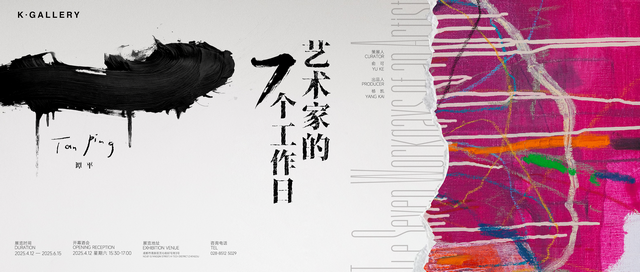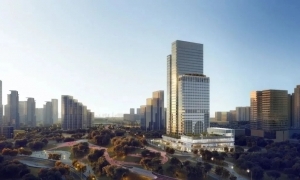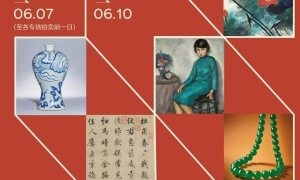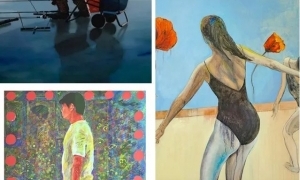1970年 出生于中国四川省合川县,自幼热爱绘画。
1970 Zhang Xiaotao is born in Hechuan, Sichuan. From a very early age, he shows a keen interest in drawing.
1980年 因为热爱连环画而迷上绘画,参加学校的美术兴趣小组,利用课余时间摆书摊,出租连环画,一直到1984年。
喜欢读书,如:《徐悲鸿》、《齐白石》、《美术》、《世界美术》、《新美术》等杂志。
向初中美术老师曾祥兴学习书法、素描、色彩。拜师王远海学习峨嵋派武术。
1980 The young Zhang’s love of picture-story books prompts him to rent them out on the street in his spare time and join the school’s art club. An avid reader, he devours books on fine arts and Chinese artists such as Xu Beihong and Qi Baishi. He also reads emerging prominent art magazines World Art and New ARTS. He studies calligraphy, sketching and color with his middle school fine arts teacher Zeng Xiangxing. He is also a student of Master Wang Yuanhai in Emei-style martial arts.
1988年 与同学何松涛就读于四川美术学院附中补习班,附中考试失败。
就读于合川七间中学高中部。受尹宏杰老师影响,临摹大量的中国古代线描。
1988 Having failed the entrance examination to the Attached Middle School of the Sichuan Fine Arts Institute, he and classmate He Songtao attend the school’s night classes. Meanwhile he attends high school at the Hechuan No. 7 Middle School. During this period, he is greatly influenced by his teacher Jun Hongjie and tries his hand at copying a great number of classic Chinese drawings.
1989年 转学至合川瑞山中学高中部。受西南师范大学政史系潘久政老师影响,开始阅读一些哲学和历史的书籍,如尼采(Friedrich Wilhelm Nietzsche)、叔本华(Arthur Schopenhauer)、表现主义文学、《河殇》等。参加高中部辩论赛获第一名。
1989 Zhang is transferred to Hechuan Ruishan Middle School. Under the influence of Pan Jiuzheng, professor of political history at Sichuan Normal University, he starts reading books on philosophy and history, such as the works of Nietzsche and Schopenhauer, as well as works on expressionism, Heshang, etc. He takes first prize at his school’s debating meet.
1990年 在合川师范学校向程行老师学画,参加合川市中小学生艺术节获高中组第一名。
1990 Zhang studies painting with Cheng Xing from Hechuan Normal School.
1991年 报考油画专业未被录取。
1991 Zhang takes the entrance exam for oil painting studies but his application is rejected.
1992年 于重庆淳辉阁画廊参观程丛林小油画展,深受启发,获重庆市影评征文二等奖。
考入四川美术学院油画系,师从夏培跃、张方震、庞茂琨、翁凯旋、李强等老师。
阅读了《百年孤独》、《变形记》、《追忆逝水年华》、《梦的解析》、《美的历程》、
吕澎《1979-1989 中国现代艺术史》、阿纳森(Arnason)《西方现代艺术史》等。
系统的阅读了心理学和哲学的书籍,研究个案弗朗西斯科·戈雅(Francisco Jose de Goya)、埃尔·格列柯(El Greco)、埃贡·席勒(Egon Schiele)、西格蒙德·弗洛伊德
(Sigmund Freud)等。
常去长江边画风景和去重庆火车站画速写、拍照片。
买大量外国画册《德加》(Degas)、《弗洛伊德》、《博纳尔》(Bonner)、《达利》 (Salvador Dalí)等以供平时临摹。课余时间临摹于右任、王铎的书法。
1992 Zhang is inspired by Cheng Conglin’s exhibition at the Chunhui Ge Gallery in Chongqing. He takes the Essay Prize, Second Class at the Chongqing City Film Criticism Awards. He is accepted in the Oil Painting Department of the Sichuan Fine Arts Institute where his professors include Xia Peiyue, Zhang Fangzhen, Pang Maokun and Li Qiang. He reads famous works of foreign literature such as García Márquez’s One Hundred Years of Solitude, Kafka’s The Metamorphosis, Proust’s À La Recherche du temps perdu and Freud’s Interpretation of Dreams in addition to works on art and art history, such as Li Zezhou’s A Path of Beauty, A Study of Chinese Aesthetics, Lü Peng’s History of Chinese Art 1979-1989, and Arnason’s History of Modern Art. He delves into readings on psychology and philosophy and the study of the lives and oeuvres of Goya, El Greco, Schiele and Freud. He often sketches and photographs the landscape of the shores of the Yangtze River and the Chongqing train station. He purchases a fair number of art books of foreign artists such as Degas, Bonner, Dalí, and copies their work in his free time. He also studies the calligraphy of You Ren and Wang Feng.
1993年 去四川綦江县东溪镇写生,尝试把国画语言运用到风景写生中。
在合川工人俱乐部教美术培训班,去西安旅行,对传统文化很感兴趣 。
文学课受彭逸林老师的影响较大,了解了象征主义与死亡哲学,阅读波德莱尔(Baudelaire)《恶之花》,王尔德(Wilde)、李商隐的诗词。
《中国美术史》受李来源老师影响,开始研习中国古代画论。
1993 Zhang travels to Dongxi Township, Qijiang County, Sichuan to sketch. During this period, he tries to incorporate Chinese traditional painting language into the treatment of the landscape in his sketches. He teaches an art workshop at the Hechuan Worker’s Club. He travels to Xi’an where he is interested in traditional culture. Thanks to his literature teacher Peng Yilin, he gets acquainted with symbolism and the philosophy of death, and reads Baudelaire’s The Flowers of Evil, Wilde and poems by Li Shangyin. After reading Li Laiyuan’s History of Chinese Art (Zhongguo Meishu Shi), he begins to study ancient Chinese art theory.
1994年5月 获四川美术学院《请载轩》二等奖学金。
去川西红原诺尔盖藏区写生,对藏传佛教产生浓厚兴趣。
May 1994 He is awarded the Qingzhaixuan scholarship by Sichuan Fine Arts Institute. He travels to Zorge, in the remote Tibetan grasslands of north Sichuan, where he develops a profound interest in Tibetan Buddhism.
1994年6月 受庞茂琨油画语言影响,阅读了《中国艺术史》、《西方美术史》、《西方70、80年代艺术史》、《金枝》、《藏传佛教与心理学》等书籍。
June 1994 Zhang is influenced by the visual language of Pang Maokun’s work. He continues his readings in Chinese and Western art history with a new focus on Western art from the ‘70s and ‘80s, as well as reads Frazer’s The Golden Bough and Moacanin’s Jung’s Psychology and Tibetan Buddhism.
1994年10月 前往成都看“中国经验”展,印象非常深刻,对张晓刚、周春芽、叶永青、王川、毛旭辉的作品产生强烈的好奇,开始研究中国当代艺术,对“中国经验”画册进行了认真的研读。
October 1994 Zhang travels to Chengdu to see China’s Experience which features works by Zhang Xiaogang, Zhou Chunya, Ye Yongqing, Wang Chuan and Mao Xuhui. The show leaves a deep impression on Zhang. Fascinated by what he sees, he delves more deeply into the research of Chinese contemporary art and give the show’s catalogue a thorough reading.
1994年11月 创作了处女作《别为我众说纷纭》,受弗朗西斯·戈雅的黑色组画影响。
November 1994 Zhang produces his first work Don’t Tell Me Opinions Vary, inspired by Goya’s Black Paintings.
1995年6月 与廖一百、杨冕商量做展览、11月与张晓刚、王林、叶永青老师座谈“个人经验”展。
June 1995 Zhang Xiaotao, Liao Yibai and Yang Mian discuss holding a joint exhibition entitled Personal Experience Show in response to the China Experience of their predecessors. Later in November, Zhang informally discusses the plan with China Experience organizers and artists Zhang Xiaogang, Wang Lin and Ye Yongqing.
1995年9月 阅读《基督就是道路》、《向死而生》、《Art Today》,刘小枫《拯救与逍遥》,《与实验艺术家的谈话》、《杜尚传》(Marcel Duchamp)、《马格里特》(Rene Magritte)等。
尤其喜欢马克思·贝克曼,并创作油画作品《此在和彼在的人们》。
September 1995 Zhang’s interests are turned towards Christianity, fiction, experimental art, Art Today magazine, Marcel Duchamp and René Magritte. He takes special interest in Max Beckman. He paints People Here and There (Ci Zai he Bi Zai de Renmen).
1996年6月“个人经验”展在四川美术学院陈列馆开幕,认识了黄专、顾丞峰老师。展览场刊“个人经验”,展览结束后举行研讨会。
June 1996 Personal Experience Show opens at the Art Museum of the Sichuan Fine Arts Institute. A symposium entitled Personal Experience continues after the exhibition closes. Zhang meets curator Huang Zhuan and art critic Gu Chengfeng.
1996年7月 与川美同学刘春尧等毕业后分配到了西南交通大学人文学院美术系。
July 1996 Upon graduating for the SFAI, Zhang and classmate Liu Chunyao are assigned to the Fine Arts Department of Southwest Jiaotong University in Chengdu, Sichuan.
1996年10月 实验拼贴,研究唐卡艺术和马克思·贝克曼(Max Beckman)的个案。
阅读《后现代知识状况》、《性史》、《一个解构主义的文本》、《七世纪前中国的思想和信仰的世界》、《万历十五年》、《荣格与心理学》、《符号帝国》等。
October 1996 Zhang experiments with collage, and studies Tibetan thangka art and the works of Max Beckman. His reading interests turn towards Chinese history on the one hand with Ge Zhaoguang’s Chinese Religion, Thought and Knowledge before the Seventh Century (Qi Shiji Qian Zhongguo Zhishi, Sixiang yu Xinya Shijie), and Ray Huang’s 1587; A Year of No Significance and more recent works in Western, mainly European thought, on the other, with Lyotard’s The Postmodern Condition: A Report on Knowledge, Foucault’s History of Sexuality and Barthes’ A Lover’s Discourse: Fragments and The Empire of Signs , He pursues his interest in Jungian psychology.
1996年12月 和邓怀宇结婚。
毕业创作《此在和彼在的人们》获鲁迅美术学院“美苑杯”一等奖。
December 1996 Zhang marries Deng Huaiyu. His graduation project People Here and There wins the Lu Xun Academy of Fine Arts “Meiyuan Cup”, First Class.
1997年1月 创作《密语婚纱》系列,开始学习德语。
January 1997 Zhang paints his Sweet Wedding (Miyu Hunsha) series. He starts studying German.
1997年7月 带领学生去敦煌石窟、天水麦积山石窟考察写生一个月。
在夏河参观了扎什楞卜寺等。
July 1997 Zhang takes his students on a sketching fieldtrip to the Buddhist grottoes at Dunhuang and Maiji in Gansu, and visits the Tibetan areas of the province, including Labrang Monastery in Xiahe.
1997年8月 于西南交通大学举办工作室开放展览“都市人格”。
经常去玉林小区,受周春芽、张晓刚的当代艺术语言影响。
August 1997 Open exhibition Urban Personality and Contemporary Art is inaugurated at the Southwest Jiaotong University Art Studio. Zhang is a regular visitor of Chengdu’s Yulin District, a neighborhood famous for its cafés and its emerging artist’s community, where he comes into contact with the contemporary visual language of Zhou Chunya and Zhang Xiaogang.
1998年春 开始研究安岳石刻、大足石刻、龙门石窟及中国古代春宫图。
成都浓厚的商业文化气息,有别于重庆的后工业城市气质,开始反思当代艺术中流行文化的泛滥,以及当代文化与历史文脉的视觉和精神的联系。读徐冰和冯博一的访谈受启发很多!
Spring 1998 Zhang takes an interest in Buddhist bas-reliefs in Anyue and Dazu counties, Longmen caves and Ming Dynasty drawings. In Chengdu’s bustling and emerging commercial environment, Zhang begins to reflect upon the acceptance of contemporary art into mainstream culture and the visual and psychological links between contemporary culture and historical literature. He is inspired by reading Feng Boyi’s interview of Xu Bing.
1998年10月 经周春芽老师介绍,认识了德国瓦尔特·舒里安(Walter·Schurian)教授,他收藏了作品《快乐时光之三》(Joyful Time),并一直保持书信交往。
October 1998 Zhou Chunya introduces Zhang to Walter Schurian, professor of psychology at the Westfälische Wilhelms-Universität Münster, who acquires A Joyful Time, The collector and the artist establish a correspondence.
1999年4月 湖南美术出版社出版个人画册《都市之镜——张小涛》。
April 1999 Hunan Fine Arts Publishing House publishes an art book of Zhang’s work entitled Urban Mirror—Zhang Xiaotao (Dushi zhi Jing—Zhang Xiaotao).
1999年5月 参加《99’上河美术馆学术邀请展》,由张晓刚策划,黄专撰文批评,与黄专老师一直保持学术上的书信来往。《快乐时光之二》作品被上河美术馆收藏。
May 1999 1999 Academic Exhibition opens at the Upriver Gallery in Chengdu. Curated by Zhang Xiaogang and reviewed by Huang Zhuan, the group exhibition features Zhang’s A Joyful Time No. 2 which is acquired by Upriver Gallery. Zhang establishes an academic correspondence with Huang.
1999年8月 应德国明斯特大学邀请赴德国、奥地利、意大利参观考察美术馆和博物馆。记下了大量旅行笔记和拍摄了大量的资料,参观49届威尼斯双年展,尤其喜欢南非威廉·肯特里奇震撼心灵的作品。在维也纳拜访了阿尔弗雷德·尔德里卡、鲁道夫·豪森纳等的工作室。
August 1999 Zhang Xiaotao is invited by Universität Münster to visit German, Austrian and Italian museums as well as attend the 49th Venice Biennale. He is struck by Wiliam Kentridge’s work. In Vienna, he visits the studios of Alfred Hrdlicka and Rudolf Hausner. He keeps an extensive log and photo album of his travels.
1999年“99’南当代油画学术交流展”在南京师范大学美术学院展出,认识了管策、李小山、毛焰,并在南京师范大学美术学院做“欧洲当代艺术介绍”的讲座。
《雕塑》杂志1997年第4期发表了文章《在天堂与地狱之间》。
德国《MUSIK-TAUZ-UND KUNSTTN-ERAPIE》1999年第2期,发表文章《美丽动人的侵蚀》。
《展览的意义》发表于《现代艺术》2001年第2期。
1999 During the 1999 Nanjing Contemporary Art Exchange Exhibition (’99Nan Dangdai, Youhua Xueshu Jiaoliu Zhan) held in the Nanjing Normal University, Zhang gives a introduction on contemporary European art and meets artists Guan Ce, Li Xiaoshan and Mao Yan. Throughout the year, several of Zhang’s articles appear in reputable art journal: Scupture (Diaosu) magazine publishes Zhang’s article “Between Heaven and Hell “(“Zai Tiantang yu Diyu zhi Jian”) (volume 4); German journal Musik Tanz Und Kunsttherapie publishes “Beautiful and Moving Erosion”; and “The Meaning of Exhibition” (“Zhanlan de Yiyi”) appears in Contemporary Art
1999年12月 日本著名策展人伊东顺二访问工作室。
December 1999 Renowned Japanese curator Ito Junji visits Zhang’s studio.
2000年3月 随同W·舒里安访问四川美术学院并做学术报告,参观了大足石刻和川美艺术家工作室。
March 2000 Zhang accompanies Walter Shurian on an academic visit to the Sichuan Fine Arts Institute, and the Dazu Buddhist grottoes.
2000年6月 到巴黎阿基阿尼基画廊举办个展,9月到德国慕尼黑哈特曼画廊举办个展,并参加W·舒里安策划的关于心理学的国际当代艺术展“梦和画意之间—1900-2000维也纳”于德国卡朋柏格宫。与德国朋友海天涯﹑托马斯一起参观了柏林﹑莱比锡﹑慕尼黑的艺术家工作室和当代艺术博物馆。
June 2000 Zhang holds solo exhibitions at several European galleries over the following months, including the Galerie Akie Aricchi in Paris, and the Hartmann Gallery in Munich, as well as takes part in Between Dreams and Picturesque Meaning, Vienna Between 1900 and 2000, curated by Walter Schurian at the Schloss Cappenberg. He visits the galleries, studios and contemporary art museum of Berlin, Leipzig and Munich with several German friends.
2000年8月 应旧金山天石玛丽基金会邀请于美国奥克兰亚太桥画廊举办个展“虚构的影像”,并在旧金山工作一个月。于Mills College举办《中国当代艺术》讲座。访问旧金山现代美术馆和亚洲艺术基金会艺术家工作室。
August 2000 Fabricated Images, sponsored by Heavenly Stone Foundation of San Francisco, is held at the Pacific Bridge Gallery in Oakland, California. Zhang works in San Francisco for a month. He delivers a lecture on Chinese contemporary art at Mills College. He visits the studiosof the San Francisco MoMa and the Asian Cultural Council.
2000年12月 在成都现代美术馆举办的当代艺术峰会上,做“中小型展览的意义”的学术报告。
去重庆拍重庆钢厂的录像和摄影记录的资料,构思准备《欲缸》系列作品。
December 2000 Zhang presents a paper entitled The Meaning of Small-Scale Exhibitions in China (Zhongguo Xiaoxing Zhanlan de Yiyi) at the Contemporary Art Summit organized by the Chengdu Museum of Modern Art. While beginning work on a video and still photography project on steel mills in Chongqing, Zhang comes up with the concept for the The Box of Desire series.
2001年4月 于日本东京画廊举办“梦里的花儿”个展,参观了东京现代美术馆,认识了日本年青艺术家金田胜一(Kaneda Showichi)等。
April 2001 Zhang’s solo exhibition Flowers in the Dream runs at the Tokyo Gallery. While in Japan, he visits the Tokyo National Museum of Modern Art and meets young Japanese artist Kaneda Showichi.
2001年5月 与妻子赴北京程昕东工作室工作三个月,并做工作室开放展,出版画册,认识吴鸿﹑冯博一﹑高岭﹑黄笃等策展人。
May 2001 Zhang and his wife work for three months on Cheng Xindong Studio in Beijing, organizing the opening exhibition and publishing the catalogue. There they meet curators and critics Wu Hong, Feng Boyi, Gao Ling and Huang Du.
2001年6月 收到德国明斯特美术学院M·施奈肯伯格(Manfred Schneckenburger)院长的邀请,准备2002年赴明斯特(Muenster)举办个展。
June 2001 Zhang is invited by Manfred Schneckenburger, dean of the Kunst Akademie of Universität Münster to hold a solo exhibition in 2002.
2001年10月 赴英国伦敦红楼轩基金会参加“中国当代艺术展”。参观了大英博物馆﹑TATE美术馆 ﹑萨奇画廊﹑白庙画廊等专业艺术机构。
October 2001 Zhang is invited by the Red Mansion Foundation to London where he takes part in the group exhibition Contemporary Chinese Art. While in London he visits the British Museum, the Tate Gallery, and Saatchi Gallery and other cultural institutions.
2001年11月 参与何香凝美术馆“过渡中的青年—中、德、英当代艺术展”的组织工作,并参加展览。
November 2001 Zhang helps organize and takes part in the Youth in Transition—an exhibition of Chinese, British and German Contemporary Art at the He Xiangning Art Museum, in Shenzhen.
2002年3月 从成都到北京,租花家地西里116楼310房,认识了宋永红﹑赵亮﹑邱志杰、唐昕、陈羚羊等艺术家,初到北京,倍感孤独,思考如何表达当代现场的问题,把这些生存的恐惧、渺小、压力、糜烂的微观片断通过作品表现出来,我想把荒诞而纵欲的物质生活的片断抽样放大,这也是我面对这个物质化的欲望社会的本能的疑虑和反应,创作了《天堂》(Heaven)、《116楼310房》(Room116Building310)等作品。4月初,田畑幸人随同黄锐租798厂房,准备北京东京艺术工程的开幕展。
March 2002 Zhang moves into Room 310 Building 116, Hua Jiadi Xili in Beijing. There he meets fellow artists Song Yonghong, Zhao Liang Qiu Zhijie, Tang Xin, Cheng Lingyang. Upon his arrival in the capital, Zhang keeps closed company and reflects upon how to render contemporary reality. He pours his microcosmic snippets of existential angst, insignificance, stress and erosion into his creative work in an attempt to magnify the absurdity and lecherousness of material life. Together they constitute the artist’s doubts and meditations on the instincts of a materialistic society of desire. During this period, Zhang generates Heaven and Room 310 Building 116. In April, Tian Tianxing and Huang Rui rent out the old 798 factory and prepare the Beijing Tokyo Art Projects opening exhibition.
2002年6月 与妻子一起赴德国明斯特美术学院举办个展“欲望”,展出绘画和装置,期间与W·舒里安教授去卡塞尔文献展,参观科隆路德维希美术馆马修·巴尼(Matthew Barney)的个展,深受启发。
June 2002 Zhang and his wife travel to the Kunst Akademie of Universität Münster to put on Desire, a solo exhibition that features oil paintings as well as installation pieces. While in Germany, he accompanies Walter Schurian to Documenta Kassel and visits Matthew Barney’s solo exhibition at the Museum Ludwig Köln.
2002年10月 参加“北京浮世绘”,由冯博一策展,东京画廊是第一个进驻798的外国著名画廊,去广州艺术博物院参加了“中国艺术三年展”,由李小山、彭德策划。
阅读了大量的社会学和哲学书籍,拍摄关于798厂的资料,开始筹备“梦工厂·垃圾场”的展览。
October 2002 Zhang’s works are featured in the Feng Boy- curated solo exhibition Beijing Afloat at the Beijing Tokyo Art Projects, the first major foreign gallery to take up residence in 798 Space.
Beijing Afloat, Tokyo Gallery is the first major foreign gallery to take up residence in 798 Space. Zhang Xiaotao is featured in the Triennial of Chinese Art at the Guangdong Museum of Art. Li Xiaoshan and Peng De curate his exhibition.
Beijing Afloat, Tokyo Gallery is the first major foreign gallery to take up residence in 798 Space. Zhang Xiaotao is featured in the Triennial of Chinese Art at the Guangdong Museum of Art. Li Xiaoshan and Peng De curate his exhibition.
2003年3月 工作室搬到798料阁子。
非典期间参加了冯博一、舒阳策展的“蓝天不设防”观念艺术活动。
创作了《来自天堂的礼物》系列。(Gift from Heaven)
March 2003 Zhang moves his studio to Liao Gezi in 798 Space. During the SARS epidemic, he is featured in a conceptual art event curated by Feng Boyi and Shu Yang entitled The Blue Sky without Prevention (Lantian Bu Shefang). During this period he generates his Gift from Heaven series.
2003年9月 参加鲁虹策划的“图像的图像”于深圳美术馆,并参加深圳美术馆批评家论坛年会。参加东京画廊“两点的链接”展览和香港艺术博物馆“幻觉”展览。
September 2003 Zhang ranks among the artists featured in the Lu Hong-curated Image of Image (Tuxiang de Tuxiang) at the Shenzhen Art Museum. He takes part in the Shenzhen Art Museum ’s annual critics Forum. He is featured in Links between Two Points (Liang Dian de Jianjie) at the Tokyo Gallery, and Illusory (Huanjue) at the Museum 63 in Hong Kong.
2003年10月 在四川美术学院油画系,做“798当代艺术”讲座。介绍了北京双年展期间798的外围展,尤其重点介绍“左手与右手——中德当代艺术交流展”以及798工作室。
October 2003 Zhang delivers a lecture at the Oil Painting Department of the Sichuan Fine Arts Institute entitled 798 Contemporary Art, introducing 798’s satellite exhibitions during the Beijing Biennale, with a special focus on the 798 Space and Left Hand - Right Hand: Sino-German Exhibition of Contemporary Art.
2003年 赴巴黎阿基阿尼基画廊举办个展,在巴黎考察了博物馆和画廊。由程昕东出版社出版画册《唯物主义的糜烂》。
2003 Zhang travels to Paris to attend his solo exhibition at the Galerie Akie Aricchi. Les Éditions Xin-dong Cheng release an art book of Zhang’s work entitled Materialistic Decay.
2003年11月 带领学生去大足石刻。
重读了《柳本尊传记》、《安岳石窟》并拍摄了大量的资料为个展画册做准备。
November 2003 Zhang takes his students on a fieldtrip to Dazu, Sichuan, to study Buddhist sculpture. He rereads the biography of Tang-dynasty esoteric Buddhist master Liu Benzun and delves deeper into the study of Buddhist grottoes of Anyue County. He takes a large amount of photographs in view of a solo exhibition and catalogue.
2004年4月 与忻海洲去维也纳INFELD文化之屋,参加由W·舒里安策划的“中国今天的绘画”展。
拜访了列木敦、尔德里卡(Hrdlicka)的工作室,参观了土伦埃贡·席勒博物馆、维也纳现代美术馆。
参观W·舒里安策展的百水(HUNDERT WASS)回顾展于土伦美术馆。
April 2004 He travels to Vienna with Xin Haizhou to be featured in Chinese Painting Today, curated by Walter Schurian at Infeld-Haus der Kulturen. He visits Hrdlicka’s studio, as well as the Egon-Schiele Museum in Tulln and the Vienna Museum of Modern Art—MUMOK. He attends a retrospective exhibition Hundert Wass, curated by Walter Schurian at the Minoritenkloster Tulln.
2004年5月 参加舒阳策划的“中国影像绘画”展于北京季节画廊。
May 2004 Zhang is featured in China's Photographic Painting, curated by Shu Yang at the Art Seasons Gallery—Beijing.
2004年6月 参加意大利博洛尼亚现代艺术馆“亚洲工厂”国际展览。
June 2004 Zhang’s work is featured in the international exhibition Officina Asia at the Galleria d’Arte Moderna of MAMBo in Bologna.
2004年10月 儿子张无量在成都出生。
October 2004 Zhang’s son, Zhang Wuliang, is born in Chengdu.
2004年11月 在东京画廊举办“梦工厂·垃圾场”个展,展出绘画、草图、影像和录像访谈等。
November 2004 Zhang presents his paintings, sketches, photos and videos in a solo exhibition entitled Dream Factory - Rubbish Heap at the Beijing Tokyo Art Projects.
2004年12月 接受美国贝克尼大学评论家David Spalding的采访,他发表了论文《梦工厂·垃圾场》于英国《Contemporary Art》。
意大利《FLASH ART》2005年第3期报道了个展“梦工厂·垃圾场”。
《艺术当代》发表了W·舒里安的文章《时间的污斑》,2005年第2期发表了与张朝晖的访谈《图像的后面》。
December 2004 Zhang is interviewed by art critic David Spalding. “Dream Factory - Rubbish Heap” the article appears in the British art journal Contemporary Art. A review of Dream Factory - Rubbish Heap appears in the Italian art journal Flash Art. The Chinese magazine Art China (Yishu Dangdai) publishes Zhang’s translation of Walter Schurian’s “Blotches of Time” and Zhang’s interview of Zhang Chaohui, “Behind the Images.”
2005年春 应挪威卑尔更3·14基金会邀请举办个展。由Timezone8出版个人画册《梦工厂·垃圾场》。
Spring 2005 Zhang is awarded financial support from the 3,14 Foundation Bergen to hold a solo exhibition in Norway. Timezone8 publishes the catalogue for Dream Factory - Rubbish Heap.
2005年1月 赴意大利博洛尼亚参加“中国当代绘画”展,策展人劳伦左·萨舒里(Lorenzo·Sassoli),参观了罗马与博洛尼亚现代艺术博物馆和莫朗迪博物馆。
January 2005 Zhang travels to Bologna to take part in China Contemporary Painting, curated by Lorenzo Sassoli at the Fondazione Cassa Di Risparmio. He visits the contemporary art museums of Rome and Bologna, including the Morandi Museum.
2005年 6月 赴日本东京画廊举办“梦工厂·垃圾场”个展,田畑幸人(Yukihito)先生陪同一起参观了京都、奈良等城市及东京现代美术馆、森美术馆,与韩国策展人金善姬女士会面。
June 2005 Zhang travels to Japan to hold Dream Factory - Rubbish Heap at the Tokyo Gallery. He visits Kyoto and Nara with Tabata Yukihito of the Tokyo Art Gallery. He visits the Kyoto Museum of Contemporary Art and the Hakone Open-Air Museum. He meets South Korean curator Sunhee Kim.
2005年5月 参加南京“未来考古学”中国艺术三年展。
《亚洲艺术新闻》发表访谈“废墟里生长的罂粟花”。
May 2005 Zhang’s work is featured in Archeology of the Future at the Second Triennial of Chinese Art in Nanjing. The Asian Art News publishes an interview of Zhang entitled “Poppy Flower Growing in Ruins” (“Feixu Li Zhang de Yingsu Hua”).
2005年7月 于立陶宛国立艺术博物馆举办“幻境”个展,由Bjorn Follevaae策展。
July 2005 Zhang’s work is showcased in the Bjorn Follevaae-curated solo exhibition Dreamscapes at the M.K. Ciulionis National Art Museum of Lithuania in Kaunas.
2005年10月 再次去重庆拍摄重钢的题材。
与冯博一商谈2006年何香凝美术馆个展事项。
日本NHK电视台拍摄纪录片《废墟里生长的现代性》。
舒阳策展的“绘画路线图”于798时态空间展出,由Timezone8出版画册。
October 2005 Zhang returns to Chongqing to continue photographic work on his steel mills project. He sets plans in motion with Feng Boyi for a solo exhibition at the He Xiangning Art Museum in Shenzhen in 2006. Japanese national television NHK shoots a documentary on Zhang Xiaotao entitled Poppy Flower Growing in Ruins. His work appears in the Shu Yang-curated group exhibition The Road Map of Painting at 798 Space. Timezone8 publishes the catalogue.
2005年11月 赴澳门参加吴鸿策划的“城市的皮肤”展,展出作品灯箱《水晶》,出席第二届批评家论坛年会“当代艺术的社会学转向”并发言。
November 2005 Zhang travels to Macao where his work Crystal is featured in the group exhibition City Skin, curated by Wu Hong at the Tap Seac Gallery. He delivers a speech at the Second Annual Critics Forum entitled The Sociological Turn of Contemporary Art.
2006年8月 《绘画的抗体》发表于上海《艺术当代》2006年第3期。
August 2006 His article “The Antibody of Painting” featured in the Shanghai-based journal Art China (Yishu Dangdai)
2006年9月 参加维也纳“今日中国”展于埃塞尔美术馆,冯博一策展。
September 2006 Zhang is featured in the group exhibition China Today: Enchanting Images of a Changing World, curated by Feng Boyi at the Essl Museum in Vienna.
2006年10月 赴四川美术学院油画系举办《绘画的抗体》讲座。
October 2006 Zhang is invited by the Oil Painting Department of SFAI to lecture on The Antibody of Painting.
2006年11月 由冯博一策展的何香凝美术馆个展“美丽的混杂”,展出了2002年—2006年间的绘画、装置及动画作品。画册《美丽的混杂》由Timezone8出版。
November 2006 Beautiful Imbroglio, a retrospective exhibition showcasing paintings, installations and animations from the period between 2002-2006 and curated by Feng Boyi, opens at the He Xiangning Art Museum in Shenzhen. Timezone8 publishes the catalogue.
2006年12月 参加鲁虹、徐可策展“变异的图像”展于上海美术馆,并在研讨会上发言。
December 2006 Zhang’s work is featured in Varied Images, a group exhibition curated by Lu Hong and Xu Ke at the Shanghai Art Museum. Zhang is invited to speak at the forum.
2007年1月 工作室从798搬到环铁將府庄园文化艺术区。
英国萨奇画廊收藏作品《旅行》(Travel)、《蚂蚁搬家之三》。(The Ant Moving Things)
January 2007 Zhang moves his studio out of 798 to the Huantiejiang Fuzhuangyuan Art Community. The Saatchi Gallery purchases Travel and Ants Moving.
2007年3月 参加王林策划的展览“从西南出发”,广东美术馆。
带领助手去重钢、大足拍摄全景作品十天。
David Spalding撰写的评论文章《无止境的欲望》发表于美国《Art Papers》。
March 2007 Zhang is featured in the Wang Lin-curated group exhibition Starting from the Southwest at the Guangdong Museum of Art. He and his assistants go on a ten-day photo shoot in Chongqing and Dazu. A critique of Zhang’s art entitled Desire without Limits by David Spalding appears in Art Papers.
2007年4月 参加吕澎策划的“从新具象到新绘画”展于北京唐人艺术中心。
April 2007 Zhang is feature in the Lü Peng-curated From New Figurative Image to New Painting, at Tang Contemporary Art in Beijing.
2007年5月 参加德国W·舒里安教授策划的“诱惑的艺术—从席勒到安迪沃霍尔”,奥地利土伦艺术博物馆。
May 2007 His work is featured in the group exhibition The Art of Seduction - From Schiele to Warhol, curated by Walter Schurian at the Minoritenkloster Tulln in Austria.
2007年6月 去深圳拍摄《世界之窗》。开始创作动画《迷雾》,与李一凡商谈举办联展,与冯博一、巫鸿、魏星见面商谈具体事宜。
博洛尼亚现代艺术馆馆长劳伦左·萨舒里访问工作室,并接受他的访谈和出版计划。
June 2007 Zhang travels to Shenzhen to shoot Window to the World (Shijie zhi Men).He begins work on the animation piece Dense Fog (Miwu). He discusses plans for a joint exhibition with Li Yifan with curators Feng Boyi, Wu Hong and Wei Xing. Director of MAMBo Lorenzo Sassoli interviews Zhang at his studio and discusses plans for the publication of a catalogue.
2007年8月 带助手去西藏二十天拍摄动画片素材,参加原弓艺术机构主办的“透明之局”活动。参加范迪安馆长策划的展览“漂浮”于韩国国立现代美术馆。
August 2007 Zhang and his assistant go on a twenty-day shoot in Tibet to collect footage for an animation piece. While in Tibet, he takes part in Transparent Limits (Xiuming zhi Ju), organized by Yuan Gong Art Organization . His works are featured in Floating - New Generation of Art in China at the National Museum of Contemporary Art Korea in Seoul.
2007年9月 参加高岭策划的“动物凶猛”展于韩国墨画廊。
赴四川大学艺术学院做讲座。
参加冯博一在阿姆斯特丹Cobra现代美术馆策展的“中国现在”。
前往重庆意动动画公司做动画作品《夜》最后的修改工作,并商讨《世界之窗》的3D模型制作。
September 2007 His work is featured in the group exhibition Animal Ferocity (Dongwu Xiongmeng), curated by Gao Ling at the Gallery Mook. He is invited to lecture at the SFAI. He is invited by Feng Boyi to show his work in the group exhibition China Today at the Cobra Museum of Modern Art in Amsterdam. He adds the final touches to his animation piece Night—Animated in Chongqing and discusses a 3D production of Window to the World with Chongqing Yidong Animation.
2007年10月 由原弓策展《夜》张小涛个展于上海电子艺术节开幕,展出摄影、装置和动画,认识了B6,重新修改动画的音乐。
October 2007 A solo exhibition of Zhang’s photos, installations and animation Night—Animated is organized by Yuan Gong at the opening of the Shanghai Digital Art Festival. There Zhang meets B6 who help him with the music for Night-Animated.
2007年10月 与李一凡、孙彤洁等去云南丽江束河镇玩,并见欢庆、王磊、梁龙、孙冕等。
发表文章“从平涂到叠加”于《艺术当代》2007年第4期。
赴西班牙马德里Dolores De Sierra画廊举办个展《无止境的欲望》,展出动画、绘画、摄影等,画册由Timezone8出版。
与妻子邓怀宇前往马德里和巴黎参观艺术博物馆,去普拉多美术馆重新拜读戈雅、埃尔·格列柯、委拉斯贵支的经典绘画。去毕尔巴鄂参观古根海姆美术馆,参观托纳多教堂。
October 2007 Zhang travels to Shuhe outside of Lijiang in Yunnan. There he meets Huan Qin, Wang lei, Liang Long and Sun Mian. His article “From Simple Smear to Complex Layering” appears in Art China (Yishu Dangdai). He travels to Madrid for a solo exhibition of his animations, paintings and photos, Deseos sin Límites, shown at the Galería Dolores de Sierra. The exhibition’s catalogue is published by Timezone8. He and his wife visit the Prado where they see the works of Goya, El Greco and Velásquez. They also travel to Toledo and Bilbao to visit the Guggenheim Museum.
2007年6月—12月 与北京大学考古学家徐天进、哲学教授王守常、美学教授彭锋、西安考古学家和藏学家张建林、上海音乐人B6交流并做了访谈,准备在北京大学的个展。
June—December 2007 Zhang conducts a series of interviews with Xu Tianjin, archeologist at Peking University; Yu Shouchang professor of Philosophy at Peking University; Peng Feng, professor of Esthetics at Peking University; Zhang Jianlin, archeologist and Tibetan Studies scholar; and the Shanghai-based band B6. He prepares a solo exhibition.
2007年12月 由原弓策展“重生”张小涛个展于北京大学赛克勒考古与艺术博物馆,展出动画与 NHK纪录片、绘画、装置,展览画册由北京大学出版社和Timezone8共同出版。
参加漆澜、徐可策展的“超越的图像”于上海美术馆。
参加鲁虹策展的“阅读深圳”,参展作品《迷雾剧照·世界之窗》系列。
December 2007 Yuan Gong presents Zhang’s animations, paintings and installations, as well as the NHK documentary Poppy Flowers Growing in Ruins in a solo exhibition of Zhang’s work entitled Renaissance (Chongsheng)at the. Sackler Museum of Art and Archeology of Peking University. The exhibition catalogue is published by Timezone8. Zhang is invited to show his work in the Qi Lan and Xu Ke co-curated Super Images (Chaoyue de Tuxiang) at the Shanghai Art Museum. His Dense Fog/Window to the World (Miwu Juzhao/Shijie zhi Chuang) series is showcased in Reading Shenzhen (Yuedu Shenzhen), curated by Lu Hong.
【编辑:霍春常】






















